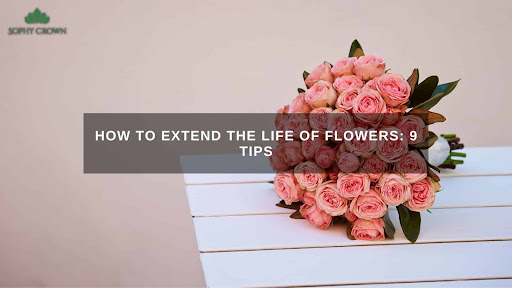Cutting Floral Foam for Flower Arrangements Fresh or fake flowers give a touch of joy and vivacity to any occasion or setting. According to SophyCrownFlowers.ie , using floral foam to create arrangements makes the cut flowers and greenery more structurally sound than if they were just floating in water or an empty vase.
Floral foam (often known to as Gooz, a brand name) is one of the most adaptable materials in the arranger’s toolset. Unfortunately, it comes with few instructions and is readily abused, resulting in disappointing (if not catastrophic) outcomes. Due to these factors, many arrangers avoid it. But if you know how to do it correctly and practise a bit, you can add it to your arranging abilities.
The following are the keys of using flowery foam:
- How to dampen foam.
- How to accommodate it in the container
- How to trim and arrange flower stems
Moistening the foam
Floral foam is an extremely lightweight and delicate open-cell substance. When dried, it should be handled with extreme care to prevent crushing the delicate cells. The cells (which are filled with air while the foam is dry) are designed to draw water through the foam by capillary action. As water is drawn in, air is expelled on the other side. When soaking the foam, it is imperative that air does not become caught in any of the cells!
The most effective technique to moisten a foam block is to allow it to do what comes naturally, which is to absorb water. Simply place the dry foam block on top of a basin of water that is at least as deep as the block’s thickness. The foam cube will gradually sink as it absorbs water from the bottom and expels air from the top. This will take two minutes, so please be patient! I use the kitchen sink, which is first cleansed with soap and water to eliminate any traces of oil or grease, and then filled halfway with tap water.
I suggest soaking the block in either normal tap water or a Listerine antiseptic solution (3 to 4 TBSP in 1 gallon of purified water). Solutions of cut flower food (e.g., FloralifeTM) will not flow as readily through the foam and will promote bacterial development, shortening the arrangement’s lifespan.
Suitable for the Container
Cut the floral foam to fit within the arrangement’s container but to protrude about 1 inch from the top of the container based on its dimensions. Having 1 inch over the top enables the placement of flowers at angles other than vertically. With floral foam that lies entirely within the container, flowers can only be placed in one direction: straight up.
Fill the container with foam. When the foam block gets wet, it becomes significantly heavier and more robust (more resilient to the touch). Now it may be carved with a sharp knife to fit the container. The foam is simply placed in the centre of a shallow, open container and secured in place with floral adhesive tape. This sort of tape, which is sold in craft stores, clings firmly to the dry surface of a container and remains in place after being sprayed with water. Do not use a different type of tape!
In a tall container, the foam should be sculpted to fit securely but not so snugly that it is difficult to shove into the entrance. (Do not crush the delicate cells!) The trick is to insert a square peg into a round hole. I often cut square or octagonal foam to fit a round hole. Simply invert the container and softly push the container opening on the foam block to create a cutting outline. The block’s edges are slightly compressed to guarantee a secure fit, while the block’s sides are not squashed at all. If the foam fits tightly in a container, crisscross tape is not necessary to secure it.
The square peg/round hole practise also provides an additional purpose. This type of fit allows water to enter the container through the gaps. If it is not possible to create a space, as with a container with a narrow neck, fill the container with water before inserting the foam and ensure that the foam neck extends far into the contained reservoir.
Traditional designs have foam that extends 2 to 3 inches over the lip of the container, allowing stems to dangle over the edge. For a secure fit, there must be at least as much foam within the container as protruding above it.
There may be filler material at the bottom of a tall container to ensure that the foam is positioned high enough. Any clean, sterile, and water-resistant substance would suffice. If a container need additional weight for stability, use washed sand; if the container is already heavy, use plastic packaging peanuts. As filler, do not recycle discarded (punctured) floral foam. Foam that has been punctured includes plant material that will contaminate the water in the new arrangement.
Used, unpunctured foam can be used as filler. However, once foam has dried up, it cannot be re-wet, therefore ensure that it is not in a position where thirsty plant stems can reach it.
Choose the proper floral foam for your floral arrangement or project, such as green floral foam for fresh arrangements and brown, firm floral foam for dried and fake flowers.
There is also foam for both fresh and non-fresh floral arrangements. Examine the available options at the craft store before purchasing one. Soak the fresh flower foam before cutting it for fresh cuts.
Removing and Replacing Stems
Cut the floral foam with a kitchen knife with a serrated blade, a hacksaw, a floral knife, or an X-acto knife. Use candlewax to wax the blade of any knife to produce cuts that are smoother and less jagged. Cut numerous pieces of floral foam or a big piece of foam using a no longer-used electric knife. Keep any kitchen knife used for cutting flower foam apart from food preparation utensils.
To facilitate the passage of water from foam cells to plant tissues, it is extremely necessary that plant stems be securely jammed into the foam. A loose connection between the stem and the foam is not only unpleasant for the design, but also fatal to the flower! Cut all the stems at an acute angle, and they will cut through the foam with precision. Additionally, do all stem cuttings under water to prevent air from entering stem cells. If the stem is prickly, remove the lowest two or three inches of the stem to prevent thorns from shredding the floral foam.
Do not pre-punch foam with holes! Attach a wooden floral pick to the stem if it is weak or crooked (which is also cut at a sharp angle). Attached to the floral pick is a wire that should be wrapped firmly around the rose stem and pick, running the wire down the length of the pick as it is wrapped, to secure the two together.
Typically, just one to one-and-a-half inches of stem must be placed into the foam for an upright placement. For a setting that is more horizontal, 2 inches will give better security. To determine the cutting length of a stem, place the stem in front of the arrangement and note where the surface of the foam would touch the stem. Cut the stem 1 to 2 inches beyond this point. If you push the stem a bit too far into the foam or if the stem encounters a barrier (such as another stem), remove it entirely. Underwater, recut the stem to reveal a new surface, then insert it in a new, unbroken slice of foam. Do not pull the stem slightly outward. That will destroy the seal between the stem and the foam!
To keep cut, moist pieces from drying out, place them in a plastic bag. It is difficult to re-soak foam once it has dried out.
For stems that will be positioned horizontally, the sliced surface should be on the top of the stem. As gravity pushes the flower downward, the surface of the foam becomes the stem’s pivot point. This implies that when the flower tries to fall, the cut end of the stem will be forced upwards (like a seesaw), forcing the cut surface of the stem into the foam.
To prevent curved stems from spinning out of position, affix a floral pick to create a rudder that prevents the stem from revolving about its axis. If the stem is too short, add a pick that extends beyond the stem’s end to strengthen it. However, do not choose every stem in the arrangement, or you will quickly run out of room in the foam!
Warning
Avoid getting flower foam in your eyes; floral foam is messy when cut or handled roughly.
Remember:
- Allow the dry foam to settle into the water.
- Place a square block in a circular hole.
- Cut each stem at an acute angle.
- Use flower picks for a variety of purposes.
Final Tips
Estimate the stem’s length. Use just enough foam to accommodate the required number of stems for the design. Three to four inches of foam should reach over the rim of a container to support a mass arrangement of 30 stems, with each stem put no deeper than two inches! For a basic line pattern, two inches of foam going over the edge should be plenty. Carefully estimate the length and location of the stems so that they only require a single poke. Exercise this! In conventional design, foam is typically “dressed” with a thin coating of greenery, such as leatherleaf fern or other plant material. Remember! Fresh or dried, all stems that go into the foam should be chopped at a sharp angle to provide a snug fit and a clean appearance.
Foam may be apparent in contemporary design, but it should not be distracting. If feasible, conceal it entirely within the container; otherwise, trim it neatly, eliminating any excess that is not necessary for structural stability. Remember that floral foam that has been drenched and dried cannot be re-wet. However, damp, unused foam can be stored in a zip-lock bag in the refrigerator for future use.
Floral Foam Achievement!
I’ve had a mass arrangement of roses in floral foam saturated with tap water last for a week after a display. I’ve had floral foam arrangements go 20 miles in a car without falling apart. At eight national rose exhibitions, my ability to construct designs the day before a show and have them seem just as fresh the next day has provided me a competitive edge. It is not magic, but rather excellent craftsmanship. Now that you know the secret, you too can accomplish it!







